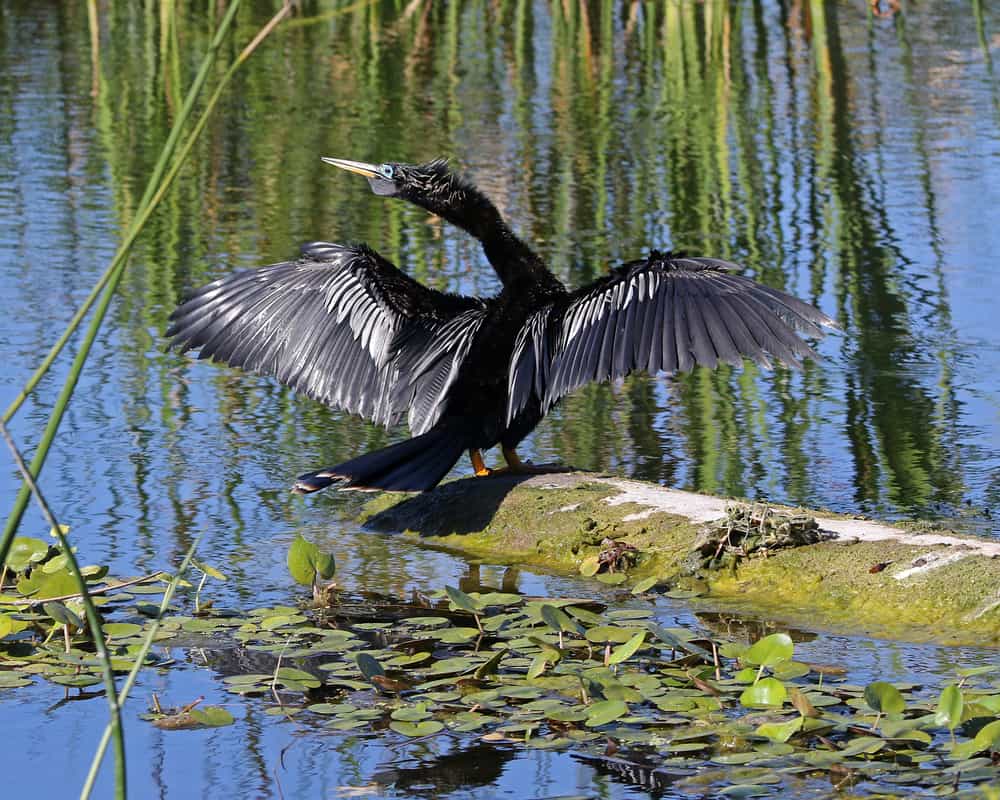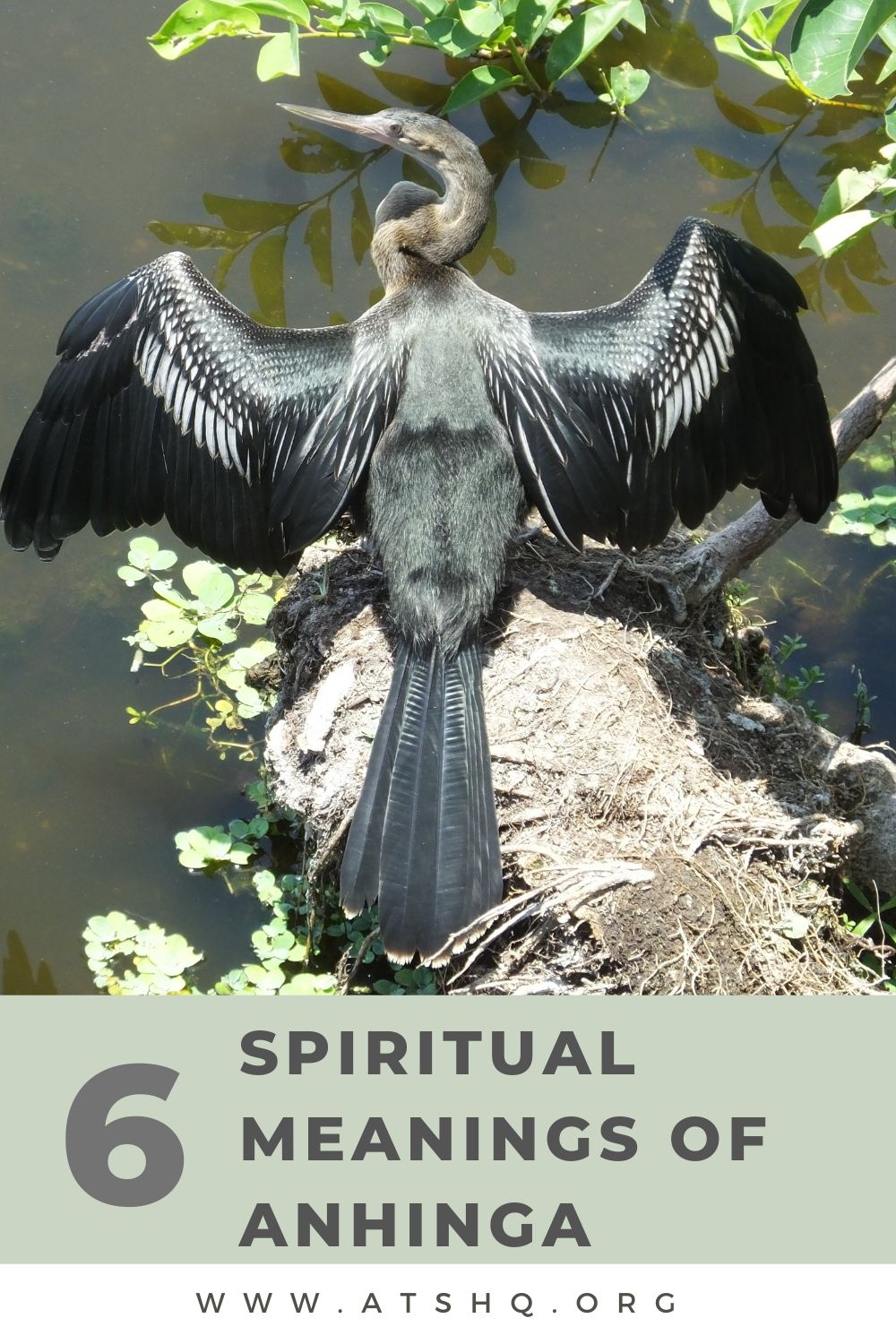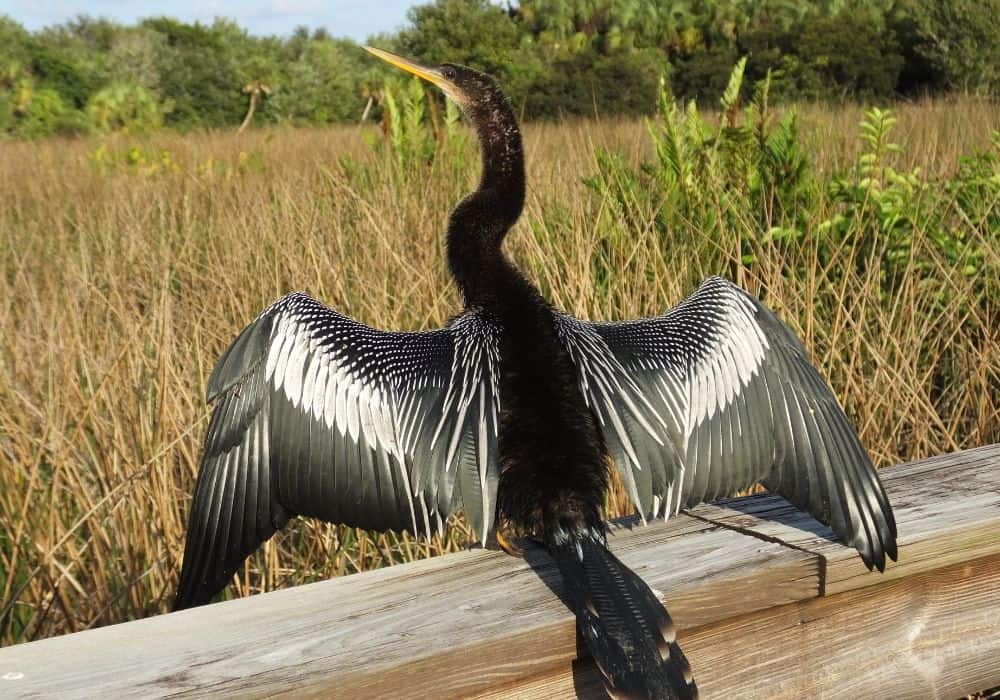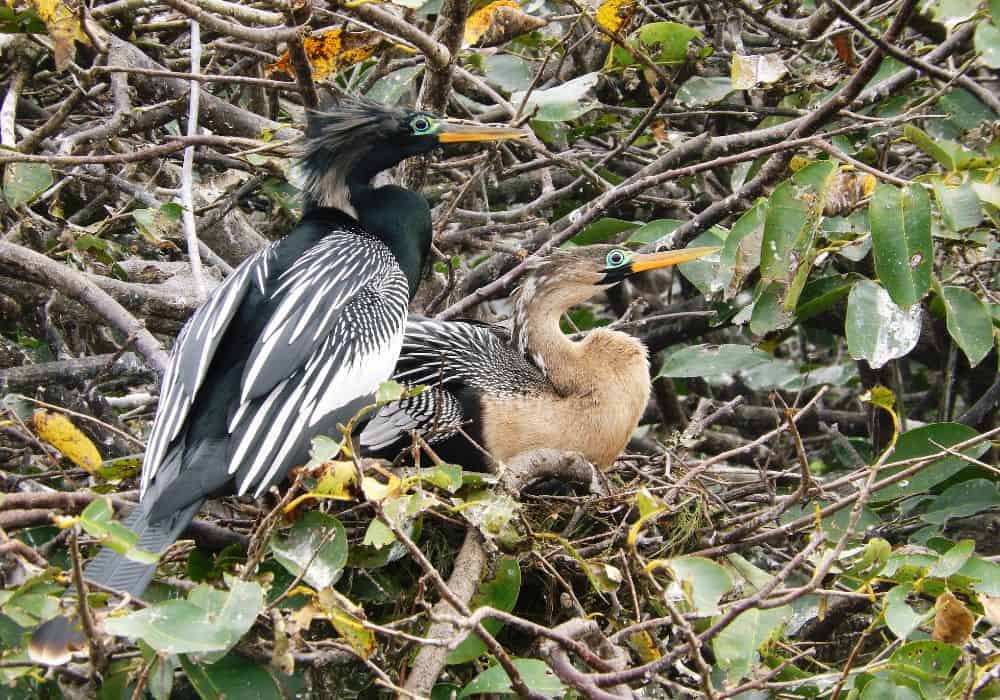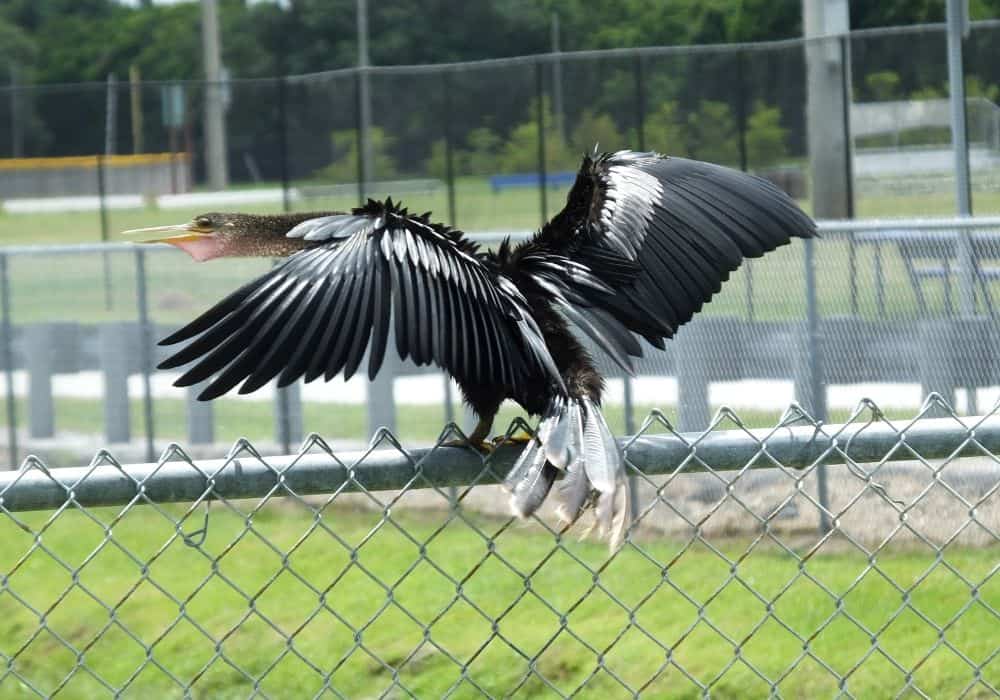With red eyes and sharp bill, the devil bird’s slithers from the river bed, raises its head above the water serpent-like, as a snake would when hunting its prey. Was it for this strange, otherworldly feeding ritual that the indigenous Amazonian Tupi people gave the Anhinga its name?
Today, the American Anhinga anhinga can be found throughout much of South, Central and south-eastern North America. A beautiful bird, it has influenced the mythologies and folklore of people from Florida to Brazil; whilst its relatives – darters and cormorants – have shaped the legends of the East with equal mystery and intrigue.
An Introduction to the Anhinga
Depending on where you come from, look at the Anhinga anhinga and you may be certain that you’ve found a new species of cormorant, or an errant darter from the Indian, African, or Australian continents and sub-continents.
But the Anhinga is its own bird, native to the warmer waters of the Amazon, Central America and the Florida Glades. In fact, though related loosely to the cormorant, the Anhinga belongs to its very own family, named after it: Anhingidae.
The name Anhinga came from the Tupi language of the indigenous Tupi people of the Amazon. The name is believed to translate as “devil bird” or “snake bird”, though it may also more directly relate to the evil forest spirit of the Tupi, called Ayinga.
In North America, the Anhinga was awarded with a slew of other nicknames, such as “Water Turkey”, given for the wedge-shaped tail which, when the males are drying, does give it the approximate appearance of a turkey from the back.
Anhinga Appearance
Anhinga’s are quite striking birds, the patterns of their feathers enrapturing the eye.
These water darters have large yellow webbed feet which they use like flippers for underwater swimming. Their long, large-yet-slender body glistens with black-green wing feathers streaked through with silvery gray, and blue-black tail feathers tipped in white.
Like swans, they have a thick and long flexible neck, which for Anhinga males are black-green, and for the females are an all over brown-white-gray ruff. The neck ends in an extremely short, slender head with small eyes, no nostrils, and a long, straight and pointed, razor-sharp beak of yellow.
Anhinga chicks hatch from their eggs bald, but gain a tan down a few days after hatching. This down turns white after about two weeks, before the first of the Anhinga feathers begin to come through at around three weeks of age.
In social settings when they are ready to mate, the eyes of Anhinga males turn a deep, shining red, which surely only contributed further to their reputation as a creature with demonic malice.
Fully-grown, adult Anhingas are on average 89cm (35″) long, and weigh around 1.22kg (2.7lbs).
Anhinga Distribution & Habitat
Anhingas thrive in their native wetlands and marshes, which still – despite the best efforts of humans – teem with fish, their natural food source. Anhingas are a bird of warm inland waters, meaning you’ll find them anywhere there are tropical waterways such as rivers, lakes, and ponds, as well as anywhere there is marshland and shrubs for nesting in.
They are local to the Amazon (and so found in every single one of the countries of modern day South America), as well as much of Central America and the southern United States; particularly in Florida.
Anhingas are widely distributed, and for that reason their conservation status is considered of least concern. They generally don’t migrate unless temperature and food availability drops significantly.
Anhinga Diet & Behavior
Anhingas are darters, which refers to water birds who have evolved to hunt for their food whilst swimming. Some birds would hunt fish from high above – like eagles and seagulls, for example – whilst others, the waders like herons and egrets, hunt by slowly walking through shallow water.
Anhingas, on the other hand, are extremely adept swimmers, and so hunt for fish by swimming underwater. It would appear that, unlike ducks, ospreys and pelicans, this bird of the family Anhingidae seems to be unable to waterproof their wings with oil from a uropygial gland.
Instead, their dense bones and water-logged feathers allow them to slowly submerge their entire body stealthily and silently below the water, from where they can dart of like a bullet toward their prey.
Anhingas are adept hunters with a tremendous work ethic, who use their sharp beaks to literally spear their catch, using only the lower jaw if the fish is small, and both jaws, slightly spread apart to act as a double-pronged fork, if the fish is larger. They then throw the fish up and back to catch it in their throat.
The Anhinga diet consists of small- to medium-sized freshwater fish. In Alabama, for example, this amounts to a diet of mullet, sunfish, black bass, catfish, suckers, and chain pickerel, as well as crayfish, crabs, shrimp, tadpoles, water snakes and small terrapins. In Florida, on the other hand, the diet extends also to include sunfishes and bass, killifishes, and live-bearing fishes.
The accuracy of the anhinga when swimming and hunting is striking, especially if you are ever lucky enough to observe the swimming anhinga beneath the waters of a crystal clear river.
These magnificent birds cannot fly particularly well if the feathers of the Anhinga are sodden, and so to dry them out – as well as for the sake of thermoregulation – they take on a curious posture with a noticeable resemblance to a cross.
Wings outstretched, facing away from the sun, they rest like this until their body temperature rises and their feathers are dry enough to fly. At this point, they will take to the skies, gliding and soaring quite competently in kettles of other Anhingas and other birds, to quite extreme heights.
It would appear, therefore, that in the aquatic life Anhingas are masters of their craft, just as they might also appear as a sky spirit, floating on the heady blue.
Anhinga Symbolism & The Devil Bird in Popular Culture
Anhingas seem always to be shape-shifting: transforming from tiny black paper gliders high up in the sky to cruciform shapes with wings outstretched, stock still under the hard morning sun, and then in an instant diving beneath the rippling water to reappear as a serpent – their slender neck dagger-like then curving.
It’s perhaps no surprise, then, that the Anhinga and its cormorant fisherman cousins should have accrued such a wealth of stories, symbolism, reverence and fear from the people who evolved around them, from the dawn of time to today.
These days, people care deeply about one’s Anhinga tattoo meaning, or believe they have an Anhinga spirit animal. Anhinga encounters feel magic and full of omens, especially to lost and weary travellers.
Let’s take a deeper look at Anhinga symbolism and the Devil Bird in modern culture.
Native American Mythology
Unsurprisingly, we must first turn to Anhinga Native American symbolism to best understand this bird. It is, after all, the indigenous peoples of the Americas who named the bird and who most deeply understand the symbology of the Anhinga totem.
The Tupi of Amazonia see in the Anhinga foreboding signs. Perhaps the uncanny shape-shifting zig-zag design of the creature is reminiscent to them of the twisting, unpredictable forms the forest can take. Either way, snakes are bad news in the jungle, and the Anhinga’s resemblance to a water snake is reason enough for the Tupi to be unnerved.
On the other hand, many more northerly Native Americans believed these birds to represent guidance and healing. Soaring high on the air, and in the next moment darting through the deeps, they saw Anhingas as great spirits of the sea and sky.
With such a unique perspective, it was clear to Native Americans that the incomparable Anhinga must be a messengers of the gods, and a being connected to the power of both storms and weather.
Ancient Greek Mythology
Anhingas – or their cormorant cousins – also appear in ancient Greek mythology; specifically, in the Odyssey by Homer. In page 50 of that book, the god Hermes – on a mission from god Apollo – “stepped from the upper air, and swooped down upon the sea, and then sped over the wave like a bird, the cormorant, which in quest of fish over the dread gulfs of the unresting sea wets its thick plumage in the brine.”
Chinese & Japanese Mythology
The ancient mythological symbolism of the Anhinga extends even as far abroad as Japan and China, where water birds like the Oriental darter are considered representatives of desirable traits such as: honor, open-mindedness, precision, strength, renewal, solitude, sacrifice, dedication, cooperation, generosity, self-knowledge, dexterity, forgiveness, and rejuvenation.
Celtic Mythology
The Celts, surrounded by cormorants and other Anhinga-like darters, reputedly attached omens of death and foreboding to these great storm birds. Unlike Anhingas, ancient Celts could not survive the rough seas, neither below nor above the water.
According to Celtic traditions and Anhinga Celtic symbolism, darters often acted as symbols of the unforgiving whims of the might ocean – turbulent seas which could put the life of a sailor at risk in seconds.
Christian Mythology
In Anhinga Christianity symbolism, the cruciform shape of the birds drying their wings would have been a clear reminder of God. Though early Christians – especially those alive at the time the Bible was written – would not have had direct exposure to Anhinga anhinga, they would have been surrounded by cormorants, darters which retain the essence of the Anhinga.
Symbolism of the Anhinga in Modern Culture
Interestingly, in modern culture the Anhinga has been written of sometimes with disdain. They have long been associated with weaknesses such as greed, despite the fact that they actually tend to feed on invasive species of fish instead of fish preferred by fishermen and so there is a flaw in this belief.
As a naturally-gifted hunter, Anhingas have sometimes been trained by people as have their cousins, for cormorant fishing. Their adaptability and usefulness in cooperation mean that, depending on your circumstances, you may either love the Anhinga or dislike it.
Conclusion
Anhingas are gorgeous and fascinating animals with a long tradition of symbolism in human mythology. Some people view Anhingas as symbols of the gods, whilst others of the devil. Some believe they represent strength, honor and cooperation, whilst others greed and avarice. What do you think? Leave a comment below!
